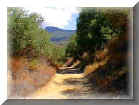

|
|
|
_____ RV Trips _____ |
|
|
The following article was e-mailed to us from our friend in Jacumba which is 32 miles to the south east. A PondAlthough there was some money spent purchasing plants for the yard we did get many of them from friends. Most wildlife features in our yard are made with little or no money. We have two small ponds. The top pond was made from a discarded 8' fiberglass satellite dish. I'd like to take credit for the idea of using the satellite disk but I read about using the dish on another birders web site. We just dug a shallow hole and dropped it in. Water is fed by a �" poly pipe that runs year round. The water drips from the pipe, which hangs off one of the dead manzanita branches that I've placed above the pond for the birds to land on. The limbs are stuck in the 3' high pile of rocks stacked next to the pond. Depending on the time of year there's various vegetation growing on the rocks. Then the water spills from this pond to a 2' x 4' lower pond that's made by using a plastic liner with rocks stacked around the edges. Both of these ponds have rocks and clay pipe placed in them for the fish, frogs and bugs to hide and breed in. The fish and vegetation in the pond were taken from our local lake. I just netted some fish and transplanted some water plants. I figured if they're doing good in the lake they'd do fine in my pond. And they did all year. The winter didn't bother them or the fish even when the pond froze. It gets in the "teens" in Jacumba in the winter. Places for the Birds to land or nest In front of the pond are our orange trees. They're not really orange trees though they're dead pecan and manzanita braches that are buried in the ground. About 3' of the branch is buried the rest sticks up into the air. They vary in length from 8' - 16' high. On these branches we stick oranges sliced in half, thus the orange trees. Since we don't have any real trees or bushes near the pond this gives the birds a place to land so they feel safer. The oranges really attract the birds. The branches will only last a couple of years but I'll have a lot more to replace them. I'll keep replacing them until the elm tree planted next to them grows into a large tree. It's only about 3' high now but it will get about 40-50' high at maturity. There are probably a total of 6 branches buried by the pond. During the spring and summer we have a lot of plants and small bushes for the birds to land, hide and feed. During the winter we use brush piles and more bird feeders to keep the birds fed and coming back to our yard. We grow birdseed during the spring and summer so we don't have to buy as much seed. Also the birds love the birdseed plants. We do have quite a few bird feeders though. There's two with birdseed mix in them, two with sunflower seed, three with thistle seed and 3-4 nectar feeders. The feeders with birdseed and sunflower seed are homemade by a friend of mine. The nectar feeders are purchased, as I can't figure out how to make them yet, but I will. We also smear peanut butter on suet feeders and branches of trees. The warblers and woodpeckers love it. We have placed several birdhouses around the property. I made a couple of them from redwood recycled from an old Jacumba carport that was laid to rest. I also bought one from a guy on E-bay. It's made of recycled redwood from torn down apartment complexes in Los Angles. Many more birdhouse will come as time goes on. I hope that this letter shows you how much we're interested in the wildlife. Birdland is an ever-evolving place where wildlife comes first. We'd be happy to give anyone a tour of our home or around the town of Jacumba.
|
B&H Ranch - Since 1999